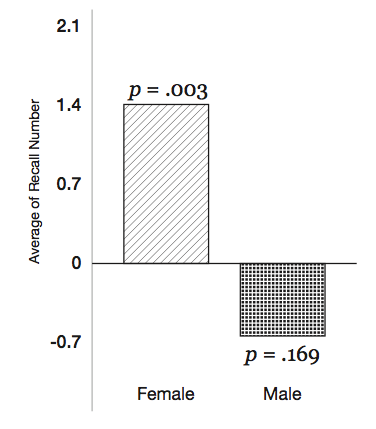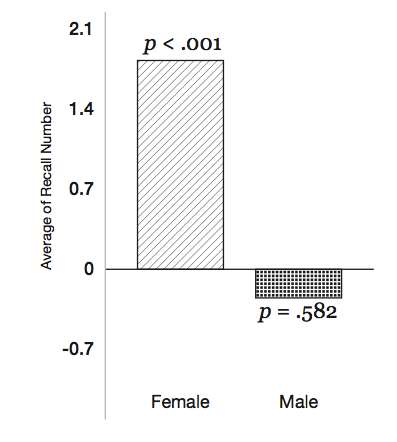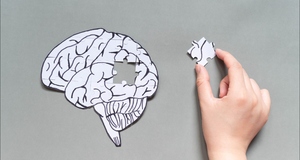Research NoteThe Influence of Gender on Long-Term Incidental Memory
By
2014, Vol. 6 No. 05 | pg. 3/3 | « Results and DiscussionData were collated and sorted by the number of male-stereotypical words recalled subtracted from the number of female-stereotypical words recalled by each participant. This resulted in a recall number. If the recall number was positive, this indicated the individual recalled more female-stereotypical words. If negative, the individual recalled more male-stereotypical words. A recall number of zero indicated equal recall of female- and male-stereotypical words. Data were, then, sorted by participant gender. A nonparametric alternative to the paired t-test, the Wilcoxon Signed-Rank Test (McDonald, 2009), was used to analyze the data. This non-parametric alternative was used since the data were not normally distributed. Alpha was set at p ≤ .05. Study 1Analysis of word list recall for the 39 female participants revealed a significant difference (p = .003) for female recall of gender-congruent, stereotypical words. Analysis of word list recall for the 42 male participants showed no significant difference (p = .169) in recall of gender-congruent, stereotypical words. Given these patterns of results, the null hypothesis (i.e., no difference in recall of gender-stereotypical words) was rejected for females, but not males. This permits acceptance of the alternative hypothesis (i.e., recall of more words congruent with the participant’s gender) for only the female sample.
Figure 1. Averages of female and male recall number. The female group showed a significant difference (p = .003) in recall of female (i.e., gender-congruent) stereotypical words. The male group showed no significant difference (p = .169) in the recall of either female- or male-stereotypical words. Study 2Analysis of word list recall for the 40 female participants revealed a significant difference (p < .001) for recall of gender-congruent, stereotypical, words. Analysis of word list recall for the 44 male participants showed no significant difference (p = .582) for recall of gender-congruent stereotypical words. For females, the null hypothesis was rejected, permitting acceptance of the alternative hypothesis. For males, rejection of the null hypothesis is not warranted.
Figure 2. Averages of female and male recall number. The female group showed significant difference (p < .001) in recall of gender-congruent, stereotypical words. The male group showed no significant difference (p = .582) in the recall of either female- or male-stereotypical words.
The results of the current studies do not align with previous research as only females showed a tendency for gender-congruent recall of stereotypical words. Previous research on gender schema theories (Signorella et al., 1997) and gender-facilitated memory (Herrmann et al., 1992) indicated both females and males were equally influenced by gender in relation to memory. LimitationsIn both Study 1 and Study 2, the female- vs. male-stereotypical words ranked higher in stereotype strength. The disproportionate stereotyped nature of these words may have influenced gender-congruent word recall. Another possible influence on the observed pattern of results is evidence showing females often outperform males on verbal tasks (Chipman et al., 1998). Females not only outperform males in verbal task, but also verbal memory (Kimura & Clarke, 2002). This predisposition could have influenced the results and contributed to the finding of gender-congruent memory in the female group. Implications and ContextExcepting these potential limitations, the implications of this study are significant. The pattern of results was the same for both of the current studies. The null hypothesis was rejected for both female groups, but failed to be rejected for males. There was concern the experimenter generated word list from Study 1 contributed to this pattern of results, thus, Study 2 was conducted, with only a change in the word list and the same pattern of results were produced. The findings from both studies imply female memory is more likely to be influenced by the gender-stereotype value of words used in text. For females, this tendency toward gender-congruent memory suggests gender influences how information is processed and remembered. Such information can, then, lead to explanations of differing memory abilities between genders. When females take in information, they may be more likely to focus on information relating to their own gender. Males seem to encode information regardless of relation to their gender. Another implication of the current set of studies relates back to Good et al.’s (2010) study of stereotypical- and atypical-images in science textbooks and the impact on performance. The impact of these textbook images on female and male recall relates to the concept of stereotype threat. Stereotype threat is the anxiety of potentially confirming a negative group stereotype when an individual believes he or she is a part of the group (Keller, 2007; Rivardo, Rhodes, Camaione, & Legg, 2011). In the current set of studies, females but not males, showed gender-congruent memory. Given this finding, it makes sense to consider a potential tendency for females to tune into gender-stereotypical information more so than males. If this is the case, this could, in turn, influence performance in educational settings, as females may face stereotype threat during study of traditionally male dominated subjects (e.g., sciences and math). By providing educational materials with information confirming stereotype threats (e.g., science textbooks with pictures of males performing experiments) individuals can be placed at a disadvantage not only in performance, but also with regard to their general feeling about the topic of study (Good et al., 2010). Gender stereotypes within learning environments should be considered. Whether in textbook images, writing style, or topic, gender stereotypes influence female memory more so than males, at least in some areas. No group should feel isolated or discouraged because the material used in classrooms is insensitive to one gender or another. Suggested research for the future could investigate ways to develop and utilize diversity inclusive and sensitive material within the classroom. AcknowledgmentsSteve Ellsworth, Department of Science and Technology, Sierra Nevada College, assisted with statistical analyses. Logan Lape, Graduate Fine Arts, Parsons The New School for Design, assisted with graphic design of figures included here and supportive documents used in presentation of this project. ReferencesBem, S. L. (1981). Gender schema theory: A cognitive account of sex typing. Psychological Review, 88(4), 354-364. Blank, H. (2005). Another look at retroactive and proactive interference: A quantitative analysis of conversion processes. Memory, 13(2), 200-224. Castelhano, M., & Henderson, J. (2005). Incidental visual memory for objects in scenes. Visual Cognition, 12(6), 1017-1040. Cherney, I. (2005). Children's and adults' recall of sex-stereotyped toy pictures: Effects of presentation and memory task. Infant & Child Development, 14(1), 11-27. Cherney, I. D., & Ryalls, B. O. (1999). Gender-linked differences in the incidental memory of children and adults. Journal of Experimental Child Psychology, 72, 305-328. Chipman, K., Kimura, D., & Fraser, S. (1998). An investigation of sex differences on incidental memory for verbal and pictorial material. Learning & Individual Differences, 10(4), 259-272. Crawford, J. T., Leynes, P. A., Mayhorn, C. B., & Bink, M. L. (2004). Champagne, beer, or coffee? A corpus of gender-related and neutral words. Behavior Research Methods, Instruments, & Computers, 36(3), 444-458. Fernandes, M. A., & Grady, C. (2008). Age differences in susceptibility to memory interference during recall of categorizable but not unrelated word lists. Experimental Aging Research, 34, 297-322. Good, J., Woodzicka, J., & Wingfield, L. (2010). The effects of gender stereotypic and counter-stereotypic textbook images on science performance. Journal of Social Psychology, 150(2), 132-147. Herrmann, D.J., Crawford, M., & Holdsworth, M. (1992). Gender-linked differences in everyday memory performance. British Journal of Psychology, 83, 221-231. Keller, J. (2007). Stereotype threat in classroom settings: The interactive effect of domain identification, task difficulty and stereotype threat on female students’ math performance. British Journal of Educational Psychology, 77, 323-338. Kimura, D., & Clarke, P. (2002). Women’s advantage on verbal memory is not restricted to concrete words. Psychological Reports, 91, 1137-1142. Liben, L. S., & Signorella, M. L. (1980). Gender-related schemata and constructive memory in children. Child Development, 51(1), 11-18. Loftus, E. (1997). Creating false memories. Scientific American, 277(3), 70-75. Martinez, M. (2010). Human memory: The basics. Phi Delta Kappan, 91(8), 62-65. Maylor, E. A. (2002). Serial position effects in semantic memory: Reconstructing the order of verses of hymns. Psychonomic Bulletin & Review, 9(4), 816-820. McDonald, J. H. (2009, September 6). Wilcoxon signed-rank test [Webpage]. Retrieved from http://udel.edu/~mcdonald/statsignedrank.html McKelvie, S. (1981). Sex differences in memory for faces. Journal of Psychology, 107(1), 109-125. Rivardo, M. G., Rhodes, M. E., Camaione, T. C., & Legg, J. M. (2011). Stereotype threat leads to reduction in number of math problems women attempt. North American Journal of Psychology, 13(1), 5-16. Signorella, M. L., Bigler, R. S., & Liben, L. S. (1997). A meta-analysis of children’s memories for own-sex and other-sex information. Journal of Applied Developmental Psychology, 18, 429-445. Taylor, F. (2009). Content analysis and gender stereotypes in children’s books. Sociological Viewpoints, 5-22. Valian, V. (2005). Beyond gender schemas: Improving the advancement of women in academia. Hypatia, 20(3), 198-213. Wagner, D. (1974). The development of short-term and incidental memory: A cross-cultural study. Child Development, 45(2), 389-396. Wood, E., Groves, A., Bruce, S., Willoughby, T., & Desmarais, S. (2003). Can gender stereotypes facilitate memory when elaborative strategies are used? Educational Psychology, 23(2), 169-180. Appendix AList of Female- and Male-Stereotypical Words used in Study 1
Note. 40-item word list generated for the purpose of Study 1. Words were rated for stereotype value and balanced for word length. Appendix BList of Female- and Male-Stereotypical Words used in Study 2
Note. 40-item word list (balanced for stereotype value and word length) sourced from a 600-item gendered and neutral word list (Crawford et al., 2004) designed to balance stereotype value. Suggested Reading from Inquiries Journal
Inquiries Journal provides undergraduate and graduate students around the world a platform for the wide dissemination of academic work over a range of core disciplines. Representing the work of students from hundreds of institutions around the globe, Inquiries Journal's large database of academic articles is completely free. Learn more | Blog | Submit Latest in Psychology |




















